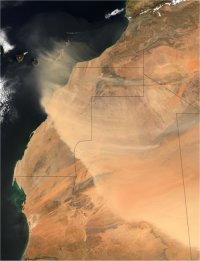Atmospher Sci & Global Chg
Research Highlights
March 2011
Saharan Dust Impacts West African Monsoon Precipitation
Using regional model simulations to predict precipitation patterns
 The Saharan Desert dust particles partially block sunlight and absorb its heat during the day. In the nighttime, the heat radiates from the sky to the land, which then warms up the surface and makes conditions ideal for nocturnal precipitation. Credit: NASA - The Visible Earth. Jacques Descloitres, MODIS Rapid Response Team, NASA/GSFC. Enlarge Image
The Saharan Desert dust particles partially block sunlight and absorb its heat during the day. In the nighttime, the heat radiates from the sky to the land, which then warms up the surface and makes conditions ideal for nocturnal precipitation. Credit: NASA - The Visible Earth. Jacques Descloitres, MODIS Rapid Response Team, NASA/GSFC. Enlarge Image
Results: Africa's Saharan Desert is the largest source of mineral dust in the world, covering more than 3 million square miles and causing dust particles to blanket African skies. According to Pacific Northwest National Laboratory's climate scientist, Chun Zhao, dust particles in the air partially block sunlight and absorb heat during the day. In the nighttime, that heat radiates from the sky to the land below and warms the surface, making conditions ideal for nocturnal precipitation. This knowledge could help predict climate changes in West Africa and elsewhere by modeling potential changes in dust associated with increasing future aridity.
Why it matters: The dust over West Africa has caused devastating droughts in the last three decades. The West African monsoon system is a major climate system and an important component of the regional hydrological cycle. Saharan dust storms impact the Earth's radiation balance by absorbing solar and terrestrial energy and are poorly understood because of limited surface observations in areas affected by these storms.
Methods: The research team used chemistry and a regional climate model to examine how West Africa's precipitation and temperatures might differ during the monsoon season if the Sahara did not produce dust. This model has been used in many regional climate and air quality studies and simulates trace gases and particulates simultaneously with meteorological fields.
The team examined shortwave and longwave radiative forces of Saharan dust and how this influences precipitation during the West African monsoon season. The study highlights the delicate balance between daytime and nighttime responses of atmospheric stability and precipitation to dust, its sensitivity to solar absorptivity of dust, and how these factors influence the overall dust-induced change of West African monsoon precipitation. A hypothetical dust-free scenario simulates up to 25 percent more rain during the late afternoon than what actually falls. Conversely, simulations that include dust reproduce the reality: Africa has more rain during the evenings and early mornings.
The Saharan dust emitted during the monsoon season can significantly affect West African monsoon development and precipitation because it interacts with both shortwave and longwave radiation and modifies the radiative and physical properties of clouds.
What's Next: More laboratory and field studies are needed to improve the characterization of dust shortwave absorption properties. Additionally, dust shortwave absorption properties used in different modeling studies should be documented clearly for proper model-to-model comparisons.
Acknowledgments: This research was supported by the U.S. Department of Energy's Earth System Modeling Program Investigations on the Magnitude and Probabilities of Abrupt Climate TransitionS (IMPACTS) project.
Reference: Zhao C, X Liu, LR Leung, and S Hagos. 2011. "Radiative impact of mineral dust on monsoon precipitation variability over West Africa." Atmospheric Chemistry and Physics 11(5):1879-1893. DOI: 10.5194/acp-11-1879-2011.
Research Team: The research team includes Chun Zhao, Xiaohong Liu, L. Ruby Leung, and Samson Hagos from Pacific Northwest National Laboratory.
